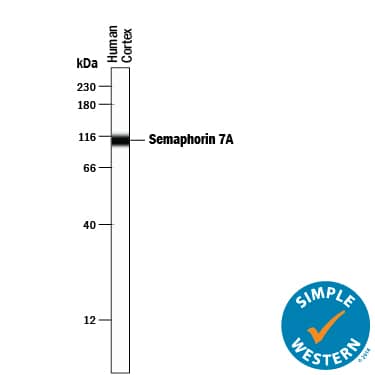Mouse Semaphorin 7A Antibody
R&D Systems, part of Bio-Techne | Catalog # AF1835


Key Product Details
Species Reactivity
Validated:
Cited:
Applications
Validated:
Cited:
Label
Antibody Source
Product Specifications
Immunogen
Gln45-Ala646
Accession # Q9QUR8
Specificity
Clonality
Host
Isotype
Scientific Data Images for Mouse Semaphorin 7A Antibody
Detection of Human Semaphorin 7A by Simple WesternTM.
Simple Western lane view shows lysates of human brain (cortex) tissue, loaded at 0.2 mg/mL. A specific band was detected for Semaphorin 7A at approximately 109 kDa (as indicated) using 2.5 µg/mL of Goat Anti-Mouse Semaphorin 7A Antigen Affinity-purified Polyclonal Antibody (Catalog # AF1835) followed by 1:50 dilution of HRP-conjugated Anti-Goat IgG Secondary Antibody (Catalog # HAF109). This experiment was conducted under reducing conditions and using the 12-230 kDa separation system.Detection of Mouse Semaphorin 7A by Western Blot.
Western blot shows lysates of mouse brain tissue, mouse testis tissue, and mouse ovary tissue. PVDF membrane was probed with 0.25 µg/mL of Goat Anti-Mouse Semaphorin 7A Antigen Affinity-purified Polyclonal Antibody (Catalog # AF1835) followed by HRP-conjugated Anti-Goat IgG Secondary Antibody (Catalog # HAF019). A specific band was detected for Semaphorin 7A at approximately 75 kDa (as indicated). This experiment was conducted under reducing conditions and using Immunoblot Buffer Group 1.Applications for Mouse Semaphorin 7A Antibody
Simple Western
Sample: Human brain (cortex) tissue
Western Blot
Sample: Mouse brain tissue, mouse testis tissue, and mouse ovary tissue
Formulation, Preparation, and Storage
Purification
Reconstitution
Formulation
Shipping
Stability & Storage
- 12 months from date of receipt, -20 to -70 °C as supplied.
- 1 month, 2 to 8 °C under sterile conditions after reconstitution.
- 6 months, -20 to -70 °C under sterile conditions after reconstitution.
Background: Semaphorin 7A
Semaphorin 7A (Sema7A, designated CD108, previously Sema K1 or Sema L), is an ~80 kDa membrane-anchored glycoprotein that is a member of the Semaphorin family of axon guidance molecules (1 - 4). On human erythrocytes, it is the John Milton Hagen (JMH) blood group antigen (4). Sema7A is the only known Class 7 or glycophosphatidylinositol (GPI)-linked semaphorin; its expression is concentrated in the brain, spleen and thymus (1 - 5). Mouse Sema7A cDNA encodes a 44 amino acid (aa) signal sequence, a 602 aa extracellular domain (ECD) including Sema and C2-type Ig-like domains, and an 18 aa propeptide/GPI membrane anchor signal sequence. Mature mouse Sema7A shares 89%, 98%, 85%, 86% and 89% aa identity with corresponding human, rat, bovine, canine and equine Sema7A, respectively. The Sema7A sema domain contains an RGD integrin interaction motif (4). Although it binds plexin-C1 in vitro and may be coexpressed with it, many of its activities depend on interaction with beta1 integrins such as alpha1 beta1 (6 - 10). Sema7A signaling through the two receptors may cause opposing effects (8). Sema7A is an immune semaphorin, with expression and activity on CD4+CD8+ thymocytes, activated T cells, macrophages and microglia (2, 9 - 12). T cell Sema7A interacts with monocytic cells, stimulating their chemotaxis, production of pro-inflammatory cytokines, and dendritic differentiation (5, 6). However, on the T cells themselves, Sema7A downregulates TCR signaling by promoting TCR internalization, modulating T cell responses (9). In lung macrophages, Sema7A is induced by TGF-beta and participates in TGF-beta -induced lung fibrosis (12). Sema7A is also expressed on pre-osteoblasts and osteoclasts, where it promotes migration and fusion, respectively; on keratinocytes, where it promotes melanocyte spreading and dendricity; and on some neurons, for example, promoting axon outgrowth in the developing olfactory tract (8, 10, 13).
References
- Yazdani, U. and J.R. Terman (2006) Genome Biol. 7:211.
- Kikutani, H. et al. (2007) Adv. Immunol. 93:121.
- Sato, Y. and (1998) Biochim. Biophys. Acta 1443:419.
- Yamada, A. et al. (1999) J. Immunol. 162:4094.
- Holmes, S. et al. (2002) Scand. J. Immunol. 56:270.
- Suzuki, K. et al. (2007) Nature 446:680.
- Pasterkamp, R.J. et al. (2007) BMC Dev. Biol. 7:98.
- Scott, G.A. et al. (2007) J. Invest. Dermatol. 128:151.
- Czopik, A.K. et al. (2006) Immunity 24:591.
- Pasterkamp, R.J. et al. (2003) Nature 424:398.
- Mine, T. et al. (2000) Tissue Antigens 55:429.
- Kang, H-R. et al. (2007) J. Exp. Med. 204:1083.
- Delorme, G. et al. (2005) Biol. Cell 97:589.
Alternate Names
Gene Symbol
UniProt
Additional Semaphorin 7A Products
Product Documents for Mouse Semaphorin 7A Antibody
Product Specific Notices for Mouse Semaphorin 7A Antibody
For research use only
